
|
Back to |
| The Front Page |
| The Game |
|
The first sextuple |
|
By Bob Alman as recalled by John Prince photos courtesy of John Prince layout by Reuben Edwards Posted February 6, 2015
|
In the "Modern Times" chapter of Prichard's HISTORY OF CROQUET, I came across these passages about Keith Wylie: "He mastered the triple-peel early in his career and it became so much a matter of tedious routine that he seemed in danger of falling asleep in the process. He set his sights on the sextuple-peel." And later, "John Solomon had never quite brought it off [the sextuple] in a tournament and it is believed that it was first accomplished by John Prince in the New Zealand Championships in 1970." What? I recalled no mention of this in the Prince autobiography we published here in 2006, and confirmed that by re-reading it. So I emailed Prince, who responded, "I don't really have any excuses! I forgot to mention the sextuple in my memoir!" When I proposed correcting the historical record, John agreed by sending me the following account, to which we added his later answers to bolded questions. And his official croquet biography in CROQUET WORLD has also been updated.
John's first response was the brief version: "It was in the final of the Hawkes Bay Easter Invitation event late March 1970 against Frank Bennett and was universally accepted as the first sextuple completed in a tournament match. Wylie completed his in the final of the British Open against Aspinall in June or July 1971."
When I asked for a more detailed account, John followed with this: "During the mid sixties I had become aware that John Solomon was attempting sextuple peels in some of his matches and as I already had a description of how to go about it from Pat Cotter's book "Tackle Croquet this way," I included it in my practice routines.
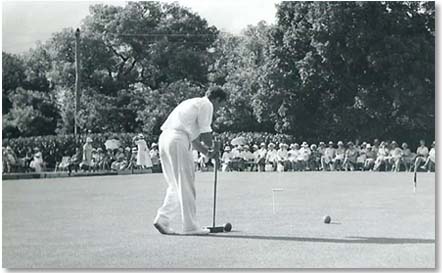
|
| John Solomon, Brisbane 1969. |
"The set-up after the first break to one-back was cross-wiring opponent at hoop one, with partner (for hoop 1) midway between one-back and the north boundary, open to both opponent balls and the striker's ball in the jaws of one-back. Putting your ball into the jaws of one-back was not that easy to achieve, and several times in trying to stop in the jaws my ball went through. This leave was known as the Standard Sextuple Leave although later, it became known as the Ladies' Sextuple Leave--possibly the invention of someone who had never completed one in a match!
"I saw John Solomon attempt a sextuple during the 1969 MacRobertson Shield Series in Australia, but he did not actually complete one in a match that year. However, following that series, Solomon visited New Zealand and in a friendly doubles partnering Arthur Ross at the Hastings Croquet Club, he succeeded. Arthur Ross recalled doing one some years earlier but was certain it was in a friendly game and not a tournament match.
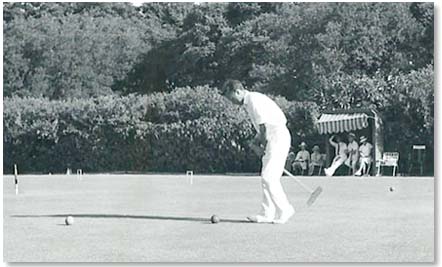
|
"I recall nearly finishing one myself during the NZCC Best Eight at Timaru early in March 1970 against Keith Woollett on a very uneven court at West End club; and then, with all the peels done, I missed the peg-out from about four yards! But having got so close, I knew it could be done.
"A few weeks later I succeeded in the final of the Hawkes Bay Croquet Association's Easter Invitation event at Hastings against Frank Bennett, a local player who played off a minus handicap. Arthur Ross was watching and was one of the first to congratulate me, saying it was the first sextuple he'd seen completed in a match. I was aware that Sir Francis Colchester-Wemyss, a member of the 1935 England MacRobertson Shield team, had written in Ross's book CROQUET AND HOW TO PLAY IT (1933 second edition) the following, 'In a recent Dominion Champion Cup, Mr. Ross won all his 18 games; in 11 of them he brought off a triple, in one a quadruple, and in one a quintuple peel.'
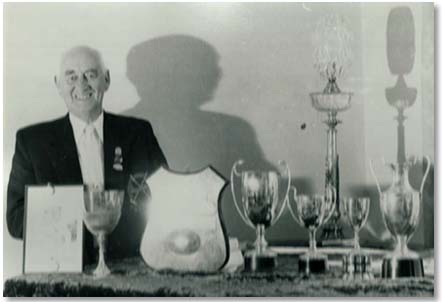
|
| Arthur Ross with a collection of his trophies. |
"News arrived from England that Keith Wylie had completed a delayed sextuple against Nigel Aspinall in the final of the 1971 British Open, a magnificent feat, and against such a formidable opponent. However, I had got there before him, a little like being the first on top of Mt. Everest, and that was a Kiwi too!"
So you and others had tried it often in competition, but failed.
Many times. During the Croquet New Zealand Best Eight Invitational at Timaru in March 1970 I had made an earlier attempt at a standard sextuple but do not remember what went wrong or how far I got. At the Hawkes Bay Easter Invitation event a few weeks later in March I recall making one attempt prior to the final but it failed when I stuck in hoop six playing for a rush to one-back. My opponent (don't recall who) missed and I attempted a septuple (7 peels) but failed to get the rover peel. So the final was going to be my last chance, as I'd be playing no more tournaments that season. That's when I nailed the sextuple against Frank Bennett.
I'm assuming your breakthrough achievement was the Standard Sextuple. I'd like you to comment on what Prichard goes on to say...."To improve upon the leave Solomon introduced, which offered an opponent a shot of only about 20 yards with a laid break if hit, 'Wylie conceived the idea of laying up in the third corner, thus lengthening the shot to over 30 yards--the Delayed Sextuple. This innovation he brought to fruition in the most spectacular setting--the final of the Open Championships against Aspinall in 1971--which clinched the title for him in dramatic fashion.'
Prichard's reference to the "New Zealand Championships" is actually incorrect, but the year is right, possibly confused by my doing another and later sextuple in the final of the New Zealand Championship Plate in January of 1971.
So you're saying you actually did the first TWO sextuples, John? The first a full 16 months before Wylie did his first one in England, and the second six months before Wylie?
Yes, and it was in the Plate! Gordon Rowling had defeated me in the main event, so in the Plate I completed my second sextuple in competition, against Bill Penman on court two at Nelson, never an easy lawn! Again, this would have been from the standard leave, but I do remember it went very well as I peeled rover going to three-back.
The length of shot with the standard leave is actually nearer to 25 yards than the 20 yard Prichard cites, as the only open ball is guarding the north boundary, unless your opponent fancies the shot at the ball in the hoop. With either leave the opponent has a laid break (assuming they're for hoop one). However, there is another advantage of the corner three leave over the standard. With the standard leave the opponent may decide not to shoot at all but play a ball into corner three, making the early stages of the sextuple more difficult.

|
| Keith Wylie and Joe Hogan at the 1982 MacRobertson matches in Australia. |
I'm unsure. I remember one against Graham Beale, the first player to achieve a sextuple peel in the USA, at Sonoma Cutrer in 1987 if my memory is correct. We played at United during a New Zealand invitation event, I only recall it because Roger Murfitt asked us who won and Graham said something like "John." Long pause. Then, "Just a delayed sextuple, nothing fancy!".
Not to disrespect Bennett, but speaking as frankly as a famously politely guy like you would permit, would you have tried to pioneer the first standard sextuple in competition if the opponent had been one of the big players of the time--a player of Joe Hogan's calibre?
Yes, because I always felt the sextuple is a tactic to be used against top players, especially ones who hit lots of lift shots, and not just a party piece against someone you'd always expect to beat. So leading up to the Hawkes Bay Invitation in 1970 it was more of a race among the top players to see who would finish one first.
And you beat them all by more than year! But then, once the top-player pioneers had done it, they continued to try it in major competitions against other top players?
Yes. I attempted to set one up against Aspinal in 1974 MacRob., at Nottingham. We were game all both with +26 T/P's., but alas my attempt to stop in the jaws of one-back went through. However, I did go on to win the match.
Playing Neil Spooner at Chatswood Sydney in the 1982 MacRob I was game up 26TP-0 and in game two intended to go for a sextuple because Neil was such a good shot and in great form. I got the opening break but in playing a croquet stroke on the west boundary my mallet touched the bank behind me on my backswing. I was unable to stop my swing and made the shot somewhat indifferently but was quite un-nerved by it.
So I went to four-back instead, and sure enough Neil hit the lift and went to four-back too. I missed and he finished 26TP-9 and he won the third 26TP-0. Keith Wylie said he expected something more enlightening from both of us! I never let on what my game plan had been!
The closest I got in the MacRobertson was in 1990 against Australian Greg Bury at Kelburn club in New Zealand, where the straight rover peel failed to go through. Of course the first sextuple in a test match was by Paul Skinley, partnering Jackson against the Australians at Rotorua, New Zealand, in 1979.
Still, some accomplished competitors of the 21st Century have commented that the sextuple is a risk only a very few at the tip-top of the rankings should ever attempt, and then only on "easy lawns" in perfect conditions. I don't recall anyone recently except Bamford doing one sextuple after another in the final knockout of the last world championship. Have I misremembered? What is your own assessment of the current risk-versus-gain formula with regard to the value of trying any form of this technique in 2015?
Very fast lawns definitely present a greater challenge when combined with Atkins Quadway hoops in very hard ground. I would imagine that even Reg Bamford and Robert Fulford may think twice about the wisdom of tackling a sextuple under those conditions. It comes back to the question, do I need to complete a sextuple to defeat my opponent? If the answer is, No I don't, then follow Nigel Aspinal's simple piece of advice: "just cut out the silly mistakes".
Shall I assume, given what you've said about the difficulty an opponent creates by shooting into corner three, that the DELAYED Sextuple is now the generally favored one by top players in major competitons?
Aspiring players generally follow what they see the very top players doing, and perhaps the frequent reference to the Standard Sextuple as the "Ladies' Sextuple" doesn't sit well with the macho men, so the Delayed Sextuple is the leave for real man, etc. But I think there was a further reason why Keith (Wylie) referred to the third corner leave as one-back tactics rather than a (delayed) sextuple leave. If the opponent already has a ball on four-back then there is the other option of doing a Triple Peel on the Opponent (TPO), perhaps a peel on partner at one-back, pegging out both balls and finishing up with a six- or seven-hoop lead.

|
| This John Prince drawing of Keith Wylie at Sonoma-Cutrer in 1987 imagines Wylie in an unceasingly quest of perfect exactitude dropping a straight-edge on a ball to determine whether it is over the string and out of bounds. |
Even the terminology "delayed" sextuple is questionable, because you start the turn on hoops one and one-back, a fairly standard position. Much as a standard triple peel turn starts, usually though not always on hoops one and four-back. Interestingly, a number of players do hit the "Tea Lady" [the terminology for the long shot at the balls by corner three. ] When it becomes the norm and they feel comfortable, they're doing the right thing. Perhaps some different one-back leaves (see EXPERT CROQUET TACTICS by Wylie) may yet evolve.
Is there any expert gambit or strategy next to be achieved by an unusually brilliant and competitive shot-maker that would improve that player's ability to win games and matches at a higher rate? Or have all those gambits and strategies already fully known and explored?
It's becoming more and more difficult to come up with something new. I recall years ago one aspiring new player was sure he'd come up with a super new leave and everyone seemed impressed, but Arthur Ross, standing quietly in the background, just smiled to himself and I knew he'd seen it before!
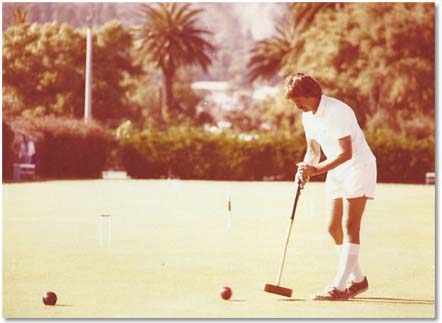
|
| John Prince becoming the New Zealand Open Champion in 1977 at the Nelson Croquet Club. |
Adopting a different approach can work. Unless you can do it better than he can, you should try not to play your opponent at his game. I recall an excellent semi-final match at the British Open in 1986 between Hogan and Aspinall. Joe had won the first +2TP and was well ahead in the second having pegged out Nigel and possibly himself, I'm no longer sure of that detail but Hogan certainly had the upper hand. Aspinall proceeded to almost turn Joe inside out with a display of brilliant tactics to win by three hoops. But in the third game, he played Hogan at Hogan's game. Joe was first to four-back. Nigel hit the lift and followed him to four-back, only to have Joe hit his lift and finish with a triple peel. Had Nigel after hitting the lift gone for the TPO he would have been playing to his tactical strength which was clearly superior to that of his opponent, as evidenced in game two.
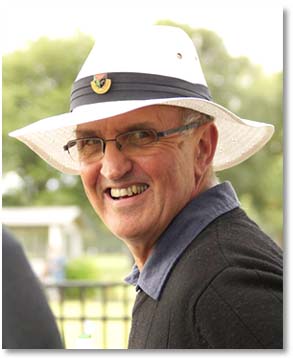
|
| John Prince at the 2014 MacRobertson series, a spectator this time! |
To win consistently at the top requires huge passion and dedication, as demonstrated by our current very best players. As in other sports there is an X factor that sets one or perhaps two players just ahead of the rest; somehow, no matter what, they prevail. In tennis a few years back it was Roger Federer; no matter how well his opponent played, Federer was just that fraction better.
I guess the ultimate play would be to hit with the second ball, go to the peg, and finish on the fourth turn. But then the difficult bit would be winning the toss of the coin at the start to ensure you went second!
There seems to be general agreement that the next stage of development at the top level requires making the game more interactive. How will that be done? Chris Clarke's answer is more difficult courts and precise settings of unforgiving hoops. Wylie's answer (in a Gazette article I republished in CROQUET WORLD some time ago) was deliberately uneven terrain. I doubt many people would propose courts of greater dimension or alternate hoop arrangement to improve upon the Willis setting. Do you have either a suggestion or an observation on what that still unrealized "advance" would be, or a guess?
Several times I've raised the thought of end of turn if you run your hoop off the court (as in US rules), but generally I'm cried down. Many times players do this intentionally, for example at two-back to ensure a rush back to the north boundary area, especially helpful when doing a sextuple and you want to get four-back peeled before making three-back.
But being required to run the hoop with control would, I have thought, provided an added challenge and thus would have made the game a little more interactive. I know in my case I often run the hoop off the court in sheer desperation to get through, following an indifferent approach! This change would put a little more emphasis on playing accurate croquet strokes with control; otherwise the emphasis stays with single-shot target shooting, in which case you should be playing Golf Croquet!
Many, including myself, have proposed an end of turn if after the initial roquet of your turn you roquet a ball off the court. This idea was first suggested as far as I'm aware by Pat Cotter back in the 1950/60's. Both these changes could perhaps be applied only to major International and National tournaments, as the game is already difficult enough for most club players.
Changing the hoop order may add to the difficulty e.g. 1, 3, 5, 2, 4, 6, etc., have been suggested; and/or varieations in the orientation, with some hoops set north/south rather than all east/west. But capable players would soon adapt to that change as well.
Adding terrain to Chris Clarke's answer would definitely increase the difficulty. Some hoops at United and elsewhere already have slopes not easily read or detected. Uneven terrain would also put some emphasis back onto accurate croquet strokes and ball placement. Wylie and Clarke are certainly on the right track.
EDITORIAL ENDNOTE: Our attempt at clarifying and correcting a footnote of croquet history may still be inaccurate or incomplete in some respects. But while primary sources are still alive, it's not too late to make correction. If you have such a comment to make, send it to this magazine and we'll make even further corrections if they are warranted. One of the great advantages of this medium is that mistakes actually can be quickly and easily corrected.